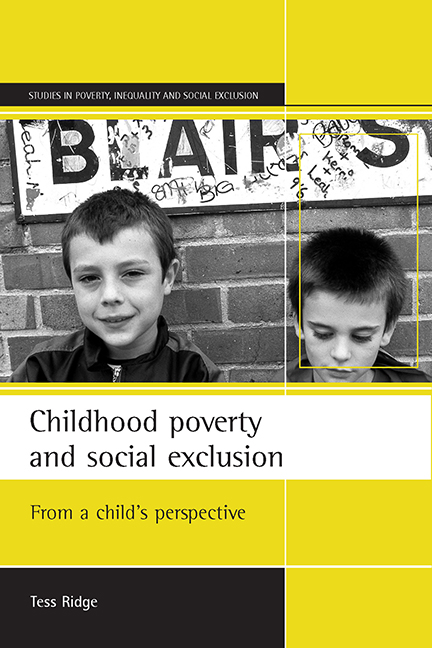Book contents
- Frontmatter
- Contents
- List of tables and figures
- Acknowledgements
- one The challenge of child poverty: developing a child-centred approach
- two What do we know about childhood poverty?
- three Children’s access to economic and material resources
- four ‘Fitting in’ and ‘joining in’: social relations and social integration
- five Family life and self-reflection
- six Experiences and perceptions of school: analysis of the BHPYS data
- seven Childhood poverty and social exclusion: incorporating children’s perspectives
- References
- Appendix BHPYS Wave 7
- Index
- Frontmatter
- Contents
- List of tables and figures
- Acknowledgements
- one The challenge of child poverty: developing a child-centred approach
- two What do we know about childhood poverty?
- three Children’s access to economic and material resources
- four ‘Fitting in’ and ‘joining in’: social relations and social integration
- five Family life and self-reflection
- six Experiences and perceptions of school: analysis of the BHPYS data
- seven Childhood poverty and social exclusion: incorporating children’s perspectives
- References
- Appendix BHPYS Wave 7
- Index
Summary
The British Household Panel Youth Survey (BHPYS) provides a valuable opportunity to develop further the notion of child-centred data, as it utilises data generated by a large sample of children responding to issues relating to their own lives. However, it is a rarely used data set, perhaps reflecting the difficulties of using a data set which has a sample size of less than 800, but also reflecting in part our embedded culture of neither listening to nor valuing what children have to say.
The British Household Panel Survey (BHPS) is a complex data set with data recorded at the individual and household level. It is a household survey and also a panel study, so data is collected at different levels and individuals are tracked as they move in and out of households. The BHPYS contains data from children and young people who live in sample households and is also an ongoing panel study, with children moving into the panel at age 11 and then out into the adult survey at age 16. Chapter Six reports the findings from quantitative analysis of a cross-section of children and young people who responded to the Wave 7, 1997 survey.
Table A1 shows that there were 720 children and young people who responded to the youth questionnaire in the Wave 7 sample. Their ages ranged from 11 to 15, 53% of the sample were boys and 47% girls. To establish receipt of Income Support/Jobseeker's Allowance (IS/JSA), households were selected using variables indicating benefit type, benefit unit, and whether or not a household was currently in receipt of that benefit. Care was taken to ensure that only children living in households where their parents or main carers were in receipt of IS/JSA were coded as such. Throughout the study, IS/JSA (benefit) children were compared to non-IS/JSA (non-benefit) children, and where significant differences emerged, further analysis was carried out. Preliminary exploration of the data indicated that age and gender were likely to be important factors and these variables were used throughout to try and unpick possible underlying explanations. For analysis purposes, children were coded into two age groups, pre-teenage (11-12 years) and teenage (13-15 years). Finally, multivariate analysis using variables derived from the main BHPS data was used to establish whether other factors were influencing the findings.
- Type
- Chapter
- Information
- Childhood Poverty and Social ExclusionFrom a Child's Perspective, pp. 169 - 172Publisher: Bristol University PressPrint publication year: 2002



